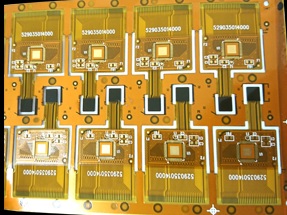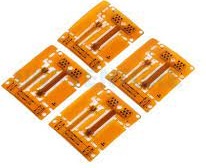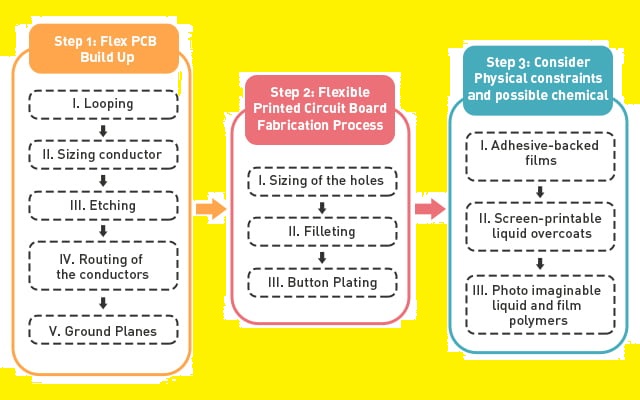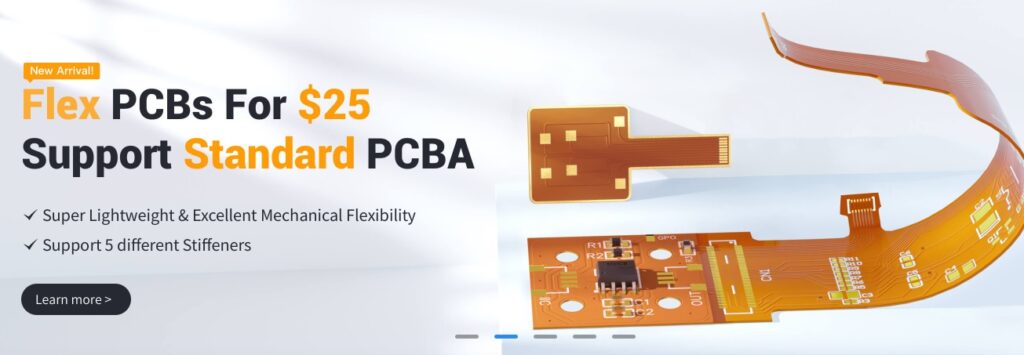Hello friends welcome to the new post. In this post, we will discuss the Overview of Flex PCB Panels: Definition, advantages, and applications. Flex PCB panels have revolutionized the world of printed circuit boards by providing a flexible and versatile alternative to rigid boards. With their ability to twist, bend, and conform to different shapes, flex PCB panels are essential components in different industries. In this post, we will discuss the definition, advantages, and use of flex PCB panels, also design considerations
Introduction to Flex PCB Panel
[adinserter block="3"]
The continuous development of electronic devices and the need for smaller, less-weight, and more compact designs are lead to the creation of flex PCB panels. These panels are created with flexible materials that allow for three-dimensional flexibility, making them best for applications where space constraints and complicated form factors exist. With their flexibility, flex PCB panels provide different advantages to rigid PCBs, making them the best for different industries.
What is a Flex PCB Panel?
A flex PCB panel, also called a flexible printed circuit board, is a PCB board that is constructed with the use of flexible substrate materials, like polyimide or polyester films. These materials offer the required flexibility, and help PCB to be twisted, bent, or folded without compromising its electrical integrity. The flex PCB panel has conductive traces and pads that interconnect electronic components mounted on the board.
Advantages of Flex PCB Panels
Flexibility and Bendability
One of the main advantages of flex PCB panels is their flexibility and bendability features. Unlike rigid boards, which are fixed in structure, these panels can be flexed or bent to fit into tight spaces or conform to complicated form factors. This flexibility is used for more compact and innovative product designs, especially in projects where space is limited.
Space-saving Design
Flex PCB panels enable space-saving designs by eliminating the need for bulky connectors and cables. The flexibility of the PCB itself allows for the direct routing of traces, minimizing the need for additional wiring. This reduction in space requirements can be particularly beneficial in portable electronic devices, where size and weight are critical factors.
Enhanced Durability
They are highly durable due to their flexible manufacturing. Contrary to rigid PCBs, which can be prone to mechanical stress and failures in high-vibration environments, these panels can withstand twisting, bending, and repetitive motion without compromising their functionality. This durability makes them best for applications that needed reliable function under harsh conditions.
Improved Signal Integrity
The flexibility of panels decreases the occurrence of signal interference and impedance mismatches. By allowing traces to be routed directly, the length and complications of signal paths can be reduced, it enhances signal integrity. This benefit is significant for high-frequency and high-speed applications, where signal quality is needed
Cost-effectiveness
While the initial cost of panels can be larger than that of traditional rigid boards, they can provide cost savings in the long run. The reduction of connectors and cables, also reducing the need for additional assembly steps, can cause in lower material and labor expenses. Though, the compact size and less-weight nature of flex panels can lead to savings in shipping and handling costs.
Applications of Flex PCB Panels:
[adinserter block="5"]
Consumer Electronics
In consumer electronics, like tablets, smartphones, wearables, and portable gaming devices, flex panels are used to accommodate the slim and compact designs required by consumers. They are used for the seamless integration of electronic components, like displays, touch sensors, and batteries, in space-constrained modules
Automotive Industry
The automotive industry uses these panels for different applications, like advanced driver-assistance systems, lighting modules, infotainment systems, and engine control units. The ability of panels to withstand temperature variations, vibrations, and complicated form factors makes it best for automotive environments.
Medical Devices
These panels are important in medical devices, like hearing aids, pacemakers, medical imaging instruments, and diagnostic tools. Their flexibility enables comfortable integration into wearable modules, while their durability makes sure reliable performance in critical medical applications.
Aerospace and Defense
The aerospace and defense industries utilize panels in, radar systems, satellite communications, and military-grade equipment. The less weight and space-saving nature of flex panels contribute to weight decrement in aircraft and space vehicles and improve fuel efficiency and performance.
Industrial Equipment
Industrial devices, like automation systems, robotics, and industrial control panels, often need flexible and compact PCB solutions. These panels offer enhanced reliability, reduced space needs, and improved signal integrity in these demanding industrial conditions.
Design Considerations for Flex PCB Panels
Material Selection
Selecting the accurate substrate material is important for the performance and flexibility of flex panels. Polyimide and polyester films are commonly employed due to their good mechanical and electrical properties. The material selection must also account for factors such as chemical resistance, thermal stability, and cost-effectiveness.
Bend Radius and Flexibility
Determining the accurate bend radius is important to avoid damage to the flex panel during bending or flexing. The bend radius is based on the thickness and material of the board, also the number of flex cycles required. Flexibility must also be considered to make sure the PCB board can accommodate the required range of motion.
Trace Routing and Placement
Careful routing and placement of traces are important for maintaining signal integrity and minimizing mechanical stress. High-speed signals must have controlled impedance traces and follow certain routing instructions to reduce signal degradation. Components should be placed strategically to avoid interference and make sure proper functionality.
Component Mounting
Selecting a good component mounting technique is needed for making sure reliability in flex panels. Surface mount technology is mostly used due to its compatibility with flexible substrates. Special attention must be given to component footprints, solder joint design, and thermal management to mitigate potential damaging
Environmental Factors
Flex panels can be exposed to different environmental conditions, like humidity, temperature extremes, and chemical exposure. Designers must consider the operating environment of the application and choose materials that can handle these conditions without compromising performance or reliability.
Manufacturing Process of Flex PCB Panels
The manufacturing process of flex panels follows some steps to transform flexible substrates into functional circuits. While certain processes can changes based on the complexity of the design and the required features, the general steps are
Substrate Preparation
The first step is preparing the flexible substrate material, like polyimide or polyester films. That is cleaning the substrate, applying of the adhesive layer, and laminating the copper foil onto the substrate.
Circuit Patterning
The circuit patterns, such as pad traces, and vias, are made on copper foil with the use of a combination of photolithography and etching processes. Photolithography applied a photosensitive resist to the copper foil, exposing it to UV light through a photomask, and making it form the required circuit pattern. Etching eliminates the unwanted copper, leaving behind the required traces and pads.
Component Assembly
After circuit patterning, electronic components are mounted on the flex panel with the use of surface mount technology or other good assembly methods. SMT components are soldered onto the board using reflow soldering, where solder paste is applied to the pads, and the components are heated to melt the solder and make reliable electrical connections.
Testing and Inspection
When components are mounted, the flex PCB panel undergoes testing and inspection processes to make sure its functionality and quality. This includes electrical testing to verify proper connectivity and signal integrity, as well as a visual inspection to identify any faults or issues.
[adinserter block="6"]
Finalizing the Panel
After testing and inspection, the panel is finalized by applying protective coatings or cover layers to safeguard the circuitry and enhance durability. The final panel also undergoes additional processes, like scoring, routing, or laser cutting, to separate individual boards or make specific form factors.
Challenges and Limitations of Flex PCB Panels
Complex Design Requirements
Designing flex panels can be more complicated than designing rigid PCBs. The flexible nature of the substrate needs careful consideration of trace routing, bend radius, and component placement to minimize mechanical stress and signal degradation. Designers needed to have specialized knowledge and expertise in flex board design principles.
Higher Initial Cost
Panels generally have a high initial cost compared to rigid PCBs. The specialized materials and manufacturing techniques involved contribute to the increases in expense. Though, as mentioned earlier, the long-term advantages, like space savings, reliability, and reduced assembly expenses, can offset the initial investment.
Limited Component Density
panels can have limitations in the form of component density compared to other PCBs. The flexibility of the substrate limits the use of through-hole components, and the available surface area for mounting components can be limited. Designers needed to carefully consider the weight, size, and thermal considerations of components to make sure optimal functionality.
Specialized Manufacturing Expertise
Manufacturing flex panels need specialized knowledge and skills. The processes like substrate preparation, circuit patterning, and assembly can be different from those used in rigid PCB manufacturing. Manufacturers needed to have the necessary instruments, facilities, and skilled engineers to ensure the quality and reliability of flex panels.
Design Guidelines for Flex PCB Panels
JLCPCB (Jiangxi Jialong Electronics Co., Ltd.) is a well-known PCB (Printed Circuit Boards) manufacturer and supplier situated in China.JLCPCB has been working nonstop to save expenses and increase efficiency since 2006. They pledge to always provide clients with the most affordable PCBs. JLCPCB produces PCBs at a low cost yet of the highest quality, presumably as a result of economies of scale, exceptionally high manufacturing efficiency, and low costs.
They provide a variety of PCB services, including flexible PCBs, also referred to as Flex PCBs.
JLCPCB offers high-quality flex PCB beginning at a special offer price of $25 for 5 pieces. You can order and receive a quick quotation by uploading your PCB design to the JLCPCB quote page. For new customers, $54 register vouchers are available.
There are a few things to keep in mind while ordering flexible PCBs from JLCPCB. Unlike inflexible PCB panels that employ mouse bites or V-cuts, FPC panels are constructed differently.
Requirements for Flex PCB Panels on JLCPCB
- When using metal stiffeners, internal board spacing should be 2 mm, although 3 mm is preferred.
- All-around panel boundaries of 5 mm. Except for the 0.5 mm clearance around tooling holes and the 1 mm around fiducials, copper should be present all along the borders.
- SMT fiducials and tooling holes should have a 1 mm and 2 mm diameter, respectively. The distance between the fiducials and the panel edge should be 3.85 mm. Each corner of the panel should have a fiducial and tooling hole, with the ones on the
- opposite corner being offset by at least 5 mm to serve as orientation indicators.
- Connecting tabs should have a width of 0.7 to 1.0 mm.
- Between 234 x 490 mm and 70 x 70 mm should be the dimensions of the entire panel.
- Add one fiducial adjacent to each FPC unit on panels that are going through SMT assembly. By painting over its fiducial, the board manufacturer will warn that damaged units should not be filled.




Discussions
Become a Hackaday.io Member
Create an account to leave a comment. Already have an account? Log In.